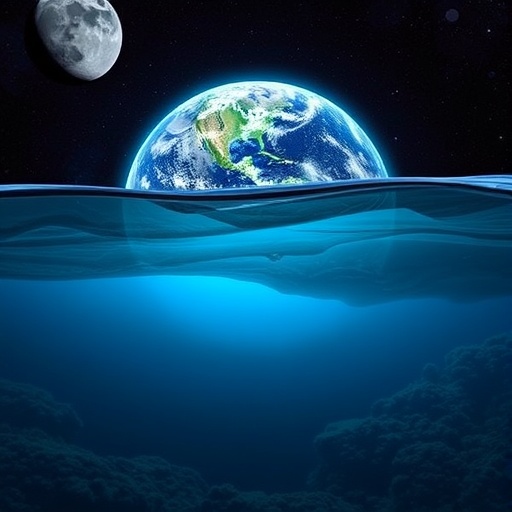In a landmark study published recently in the renowned journal Paleoceanography and Paleoclimatology, researchers from the University of Hawai‘i at Mānoa have unveiled profound insights into the intricate history of iron cycling in the South Pacific Ocean over the last 93 million years. This extensive temporal investigation, leveraging sophisticated isotopic analyses of deep-sea sediment cores, sheds new light on how iron sources have shifted dramatically through geological time, profoundly influencing oceanic ecosystems and, by extension, the global climate system.
Iron, though trace in abundance, is a pivotal micronutrient that fundamentally regulates marine biogeochemical cycles. Underpinning primary productivity, it fosters the growth of phytoplankton which, through photosynthesis, sequester atmospheric carbon dioxide. Understanding the natural variability and historical availability of iron is thus crucial for comprehending long-term carbon cycling and climate feedback mechanisms. Despite iron’s recognized ecological significance today, its historical oceanic sources and fluxes have remained enigmatic until now.
Utilizing iron isotope ratios as geochemical tracers, the research team meticulously examined three sediment cores from remote South Pacific locations, strategically selected far from continental margins to minimize terrestrial contamination. These cores provide an unprecedented geological archive, capturing subtle variations in iron input over nearly a hundred million years. Such isotopic signatures allowed the scientists to unravel the shifting dominance of different iron sources, providing a dynamic portrait of ocean chemistry evolution.
Lead author Dr. Logan Tegler, an oceanography postdoctoral researcher at UH Mānoa, explained that the study identified five discrete iron contributors: atmospheric dust deposition, two distinct hydrothermal sources emanating from mid-ocean ridge systems, iron from distal oceanic inputs, and episodic volcanic ash fallout. Over geological time scales, as tectonic movements distanced the sampling sites from mid-ocean ridges, the relative influence of these iron sources waxed and waned, reflecting both geodynamic and climatic transformations.
The findings reveal a pronounced transition in dominant iron sources. In the Paleogene, hydrothermal activity associated with mid-ocean ridges supplied the majority of iron. However, starting approximately 30 million years ago, aeolian dust began to eclipse hydrothermal inputs, assuming preeminence as the chief source sustained into the modern era. This transition correlates with significant tectonic reorganizations and global climatic cooling, highlighting the sensitivity of iron cycling to Earth system processes.
From an ecological perspective, these temporal shifts in iron supply resonate deeply with the evolutionary trajectories of marine microbial communities. Iron availability fundamentally influences phytoplankton species composition, productivity, and distribution. Dr. Tegler noted that persistent low-iron conditions likely selected for microbial populations adapted to iron limitation, such as certain diatoms with specialized uptake mechanisms, thereby modulating food web dynamics and biogeochemical cycling over millions of years.
The study further challenges prevailing assumptions about contemporary iron scarcity in the South Pacific. Despite today’s reputation as a region of minimal dust deposition and limited iron inputs, data suggest that current dust influxes may be at their highest levels in the last 90 million years. This unexpected finding implicates modern anthropogenic influences, including industrial emissions and land use changes, in amplifying iron supply to these remote oceanic waters, with potential ramifications for regional marine productivity and carbon sequestration.
Methodologically, the research employed cutting-edge mass spectrometry techniques to discern subtle variations in iron isotopic signatures (notably ^56Fe/^54Fe ratios), enabling the precise differentiation between hydrothermal, aeolian, and volcanic iron sources. This isotopic approach represents a technical breakthrough in paleoceanographic reconstructions, offering a higher resolution tool to decode nutrient cycling and source attribution than traditional bulk geochemical proxies.
Beyond paleoceanographic significance, this work holds urgent implications for understanding present-day and future biogeochemical cycles. As anthropogenic activities continue to modify iron inputs to the oceans through aerosol emissions and biomass burning, unraveling the natural baseline variability and drivers of iron supply enhances predictive capabilities. Such knowledge is vital for modeling feedbacks between nutrient cycling, phytoplankton dynamics, and atmospheric carbon dioxide regulation under ongoing climate change.
The study also spotlights the interconnectedness of tectonics, climate, and ocean chemistry. Shifting plate boundaries and volcanic activity influenced the geographic proximity of sedimentary sites to hydrothermal sources, while climate-driven changes regulated dust transport and deposition patterns. Together, these forces orchestrated the evolving iron landscape of the South Pacific, underlining the multidimensional controls on marine nutrient availability.
Furthermore, by elucidating the iron cycle’s complexity and its role in carbon uptake, this research contributes to a more comprehensive narrative of Earth’s climatic history. Iron-induced phytoplankton blooms act as biological pumps, transferring carbon from the atmosphere to ocean sediments. Fluctuations in iron supply hence ripple through carbon budgets, influencing glacial-interglacial cycles and long-term climate stability. Understanding these patterns enriches the broader discourse on natural climate variability and resilience.
Looking forward, the authors advocate for expanded isotopic investigations across different ocean basins and sedimentary archives to build a global inventory of iron flux history. Integrating such data with climate and ocean circulation models promises to refine predictions about the ocean’s role in mitigating anthropogenic carbon emissions. This advancement is particularly critical as humanity navigates the challenges of sustainable stewardship of marine ecosystems in an era of unprecedented environmental change.
In sum, the pioneering work by UH Mānoa scientists inaugurates a new chapter in paleoceanography, marrying advanced isotopic analytics with deep-time climate science. Their revelations about the South Pacific iron cycle underscore the nutrient’s profound and dynamic influence on ocean productivity, carbon sequestration, and Earth’s climate system—a narrative that will surely shape future interdisciplinary research at the nexus of geology, chemistry, and ecology.
Subject of Research: The evolution of iron cycling in the South Pacific Ocean over the Cenozoic era.
Article Title: Evolution of the South Pacific’s iron cycle over the Cenozoic
News Publication Date: 3-Jul-2025
Web References:
https://agupubs.onlinelibrary.wiley.com/doi/full/10.1029/2025PA005149
http://dx.doi.org/10.1029/2025PA005149
References:
Tegler, L. et al. (2025). Evolution of the South Pacific’s iron cycle over the Cenozoic. Paleoceanography and Paleoclimatology. DOI: 10.1029/2025PA005149
Image Credits: Richard W. Murray
Keywords: iron cycle, paleoceanography, South Pacific Ocean, isotopic analysis, hydrothermal sources, dust deposition, phytoplankton productivity, carbon sequestration, deep-sea sediment cores, Cenozoic climate change, marine biogeochemistry, tectonic influences




